|
How to Win a Nobel Prize: Laureate Roger Tsien
Gives Advice on Keys to Scientific Success at Campus Lecture
Ioana Patringenaru | Febrary 23, 2009
When doing research, find a topic that you enjoy and try to put your neuroses to constructive use. When it comes to results, accept that your batting average will be low. Find the right teammates to work with and then exploit them—kindly—for your mutual benefit.
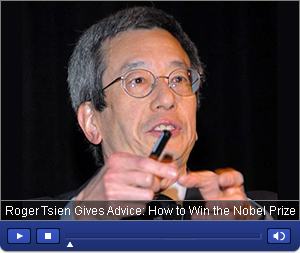
Watch Roger Tsien as he mingles with members of the Swedish royal family and talks about the whirlwind of events he took part in during Nobel Week. Tsien received his Nobel Prize in Chemistry Dec. 10 in Stockholm.
These were some of the words of advice that UC San Diego Nobel Laureate Roger Tsien shared with a standing-room only crowd at the Price Center Theater Thursday. He spoke to about 600 faculty, students and staff members about his research on the Green Fluorescent Protein, also known as GFP, which earned him the prestigious prize, and about his experiences in Sweden.
The quality of Tsien’s work is amazing, Chancellor Marye Anne Fox said Thursday. She recalled being an assistant professor and admiring his work. Tsien also is a wonderful colleague and a friend, she said. His work is used every day by scientists to develop new drugs and therapies and to better understand the inner workings of the cell, she also said. It is now being used to teach high school students about science, the chancellor added.
“Roger’s research may have started in a lab, but its application is changing lives around the world,” Fox said. “His long career on the UCSD faculty has strengthened our university as a whole.”
Vice Chancellor for Health Sciences David Brenner also congratulated Tsien. “I can’t think of anyone more deserving of the international acclaim he has received,” Brenner said. He gave Tsien a special proclamation from San Diego Mayor Jerry Sanders declaring Feb. 18, 2009 Roger Tsien Day in the city.
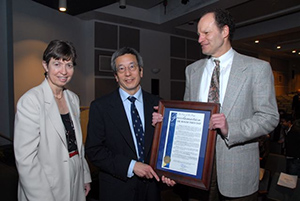
From left: Chancellor Marye Anne Fox, UCSD Nobel Laureate Roger Tsien and Vice Chancellor David Brenner. Brenner and Tsien hold a proclamation making Feb. 18, 2009 Roger Tsien Day in the City of San Diego. (Photo / Carol Sonstein)
After accepting the plaque, Tsien surveyed the audience and remarked that two years ago, about 20 graduate students turned out for the same talk. “Just because some Swedes sprinkled some fairy dust on me, now this entire mob wants to come to hear practically the same lecture,” the researcher joked. He recalled waking up around 2:25 a.m. Oct. 8 to a phone call from Stockholm. A press conference would take place in 20 minutes, someone at the other end of the line told him. “So I had to wake up and figure out what to say,” Tsien said.
In Stockholm
Two months later, in early December, he flew to Stockholm with his wife, Wendy, family, friends and colleagues, to collect his prize. He shared the honor with Martin Chalfie, of Columbia University, the first to show that GFP could be used as a genetic tag, and Osamu Shimomura, of the Marine Biological Laboratory in Woods Hole and Boston University School of Medicine, who originally discovered GFP.
Thursday, Tsien showed pictures of himself in Stockholm. In one, he sat near “the very beautiful” Princess Madeleine, the youngest daughter of King Carl XVI Gustaf of Sweden during the Nobel banquet. The UCSD researcher, who also is the youngest sibling in his family, said he and the princess talked about the virtues of their birth order.
Why GFP matters
During his Nobel lecture in Stockholm, Tsien said he had to explain why GFP is an important scientific tool. He came back to this subject Thursday at the Price Center. The fluorescent protein allows researchers to directly see biochemistry in action, he said.
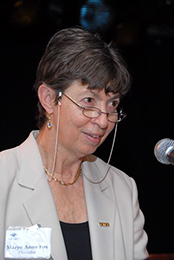
Chancellor Fox spoke Thursday.
(Photo / Carol Sonstein)
Tsien showed how, in 2007, a group of researchers at Mt. Sinai Medical Center in New York used GFP to tag the HIV/AIDS virus and watch where it goes inside individual cells. They discovered that the virus was able to inject particles into other cells through cell-to-cell contact. The finding meant that crafting a vaccine for the later stages in the disease would be difficult, because the virus never really comes out of the cells, where it would be vulnerable, Tsien said.
Another team of scientists used two different fluorescent proteins to develop a way to see where a cell was in its development cycle. They tagged cells with a yellow fluorescent protein and a red fluorescent protein. When they multiplied, cells fluoresced a greenish-yellow hue. They glowed red when they stopped doing so. Then, scientists put the cells into a mouse. Non-cancerous cells tagged this way at first multiplied, then stopped by 16 days. Meanwhile, cancerous cells kept growing, glowing bright green when scientists examined them. More important, the cells located near blood vessels were dividing much more rapidly.
“This is awesome,” Gabriel Haddad, chair of UCSD’s department of pediatrics, whispered as he listened to Tsien. As a physician, he said that the ability to see what’s happening inside the cell is a terrific tool. “It’s fantastic,” he added.
Two decades of research
During his talk, Tsien also took his audience back in time more than two decades, when he was still working at UC Berkeley. At first, he had worked on calcium signals within the cell. He later moved on to cyclic AMP, which acts as a messenger between cells. At the time, the only way to look at AMP was to harvest millions of cells and ground them up. There had to be a better way, Tsien said. Finally, he and his team concluded they needed to find a protein that responded to AMP and use it to see changes within the cell.
Tsien got in touch with Susan Taylor, a member of the UCSD faculty and an expert in that area, and she began shipping him samples to Berkeley by FedEx. They mostly arrived destroyed, denatured and non-functional, Tsien recalled. Finally, in 1989, Tsien moved to UCSD. He and his colleagues devised a mechanism that worked, but it was cumbersome.
A few years later, in 1993 or 1994, he remembered that scientists working on calcium used a luminescent protein produced by jellyfish, which reacted to calcium. It also generated GFP as a by-product. Tsien thought his lab could use GFP to label AMP directly inside the cell. He did some research and found out that Douglas Prasher, from the Woods Hole Oceanographic Institution, had cloned GFP in 1992.
Improving GFP
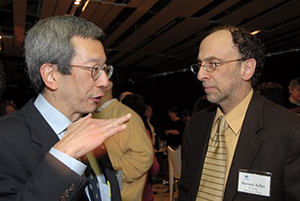
Tsien in animated conversation with Warren College Provost Steven Adler after the lecture. (Photo / Carol Sonstein)
For five years, Prasher had worked with his wife, Virginia Eckenrode, with hardly any funding. Tsien called Prasher up and, to his surprise, the Woods Hole scientist agreed to share his clone. Prasher also gave the clone to Columbia University’s Chalfie, who was the first to show that a GFP clone could be used as a genetic tag in 1994. “It was a tremendous stroke of good luck and relief,” Tsien said of the discovery that a GFP clone was indeed helpful for research. In December, Tsien and Chalfie invited Prasher and his wife to Stockholm.
Tsien and his colleagues worked to improve the GFP clone until they crafted a protein that was six-fold brighter. Working with Jim Remington, at the University of Oregon, Tsien’s lab found the crystal structure behind the protein. They submitted their work to Science. The reviewers were lukewarm, Tsien said. They essentially asked: Who cares about this protein? Why do the jellyfish make it?
It looked like Tsien’s paper was not going to get published. But around the same time, a competing team announced in an Internet discussion group that they had elucidated the crystal structure of wild-type GFP and that they would publish the following month in Nature Biotechnology. Tsien sent the announcement to the editor of Science. His paper came out shortly afterwards, scooping the rival team by a few weeks. “And of course the morale of the story is: ‘Don’t blab on the Internet, ’ ” Tsien said.
Beyond GFP
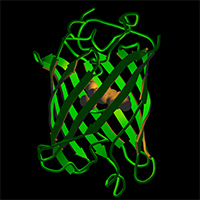
A conceptual rendering of a fusion between GFP and a peptide.
Using the crystal structure, Tsien’s lab engineered four different colors of GFP. “Finally, we had the pairs of colors that we needed to go back and to do things like cyclic AMP,” Tsien said. Later, a group of Russian scientists figured out that tropical corals also contain fluorescent proteins. Tsien’s lab used those to extend the palette of fluorescent proteins they produced. His team named the new products after fruits, from honeydew, to banana, to tangerine, to plum.
“Most major biochemical signals can or soon will be visualized,” Tsien said.
But fluorescent proteins have their limitations, he also said Thursday. Sometimes they’re too big and that makes them cumbersome to use in some experiments. They’re also hard to use in intact animals and since they all require some level of genetic engineering, they can’t be used in humans. So Tsien has now turned to bacterial phytochromes as fluorescent tags. He is particularly focusing on cancer, a disease that killed his father, his doctorate supervisor and several members of his department, he said Thursday.
Tsien’s talk earned rave reviews from several members of the UCSD community, from freshmen to seasoned faculty. Freshman Derek Bangs said he enjoyed hearing how Tsien’s work flourished through contacts with other researchers and how his research unfolded. “It was very insightful,” Bangs said.

|